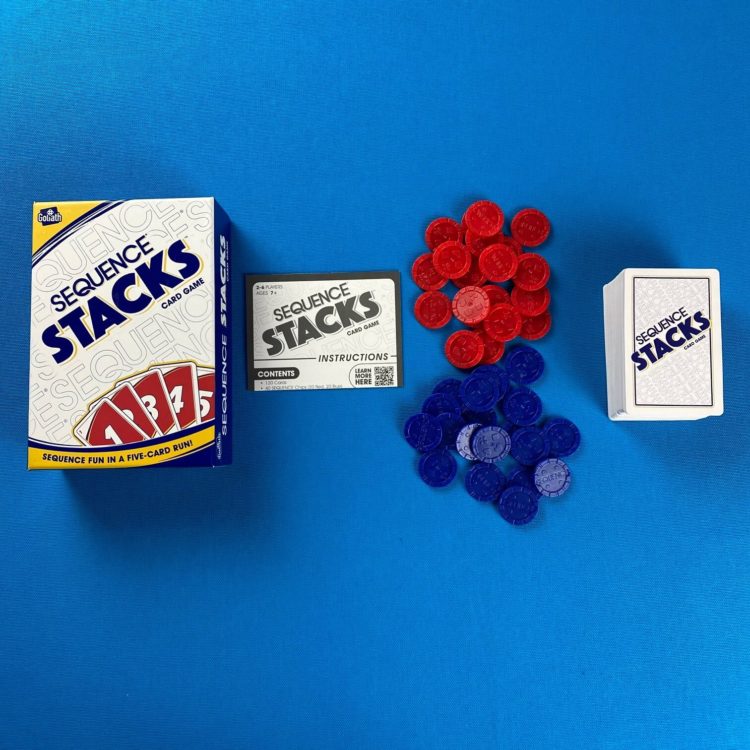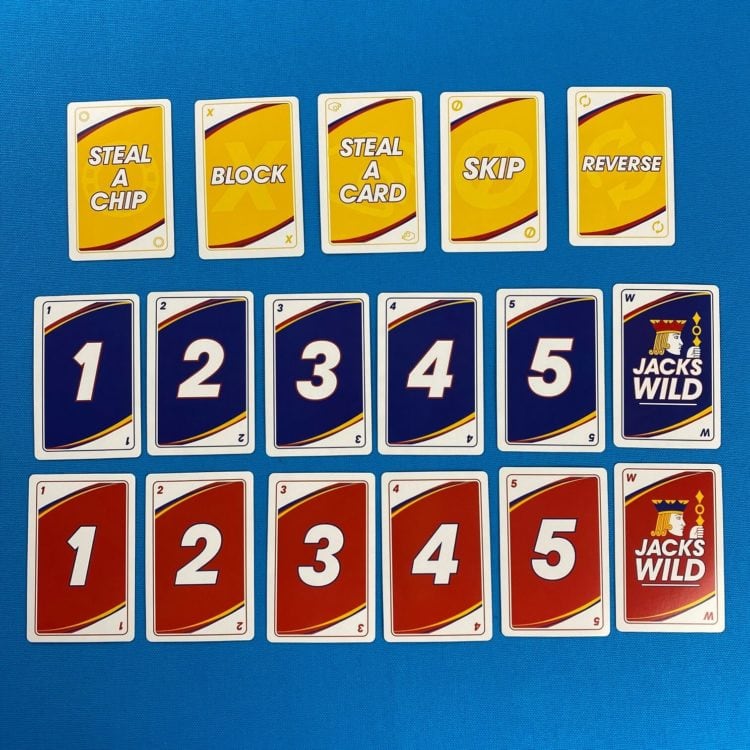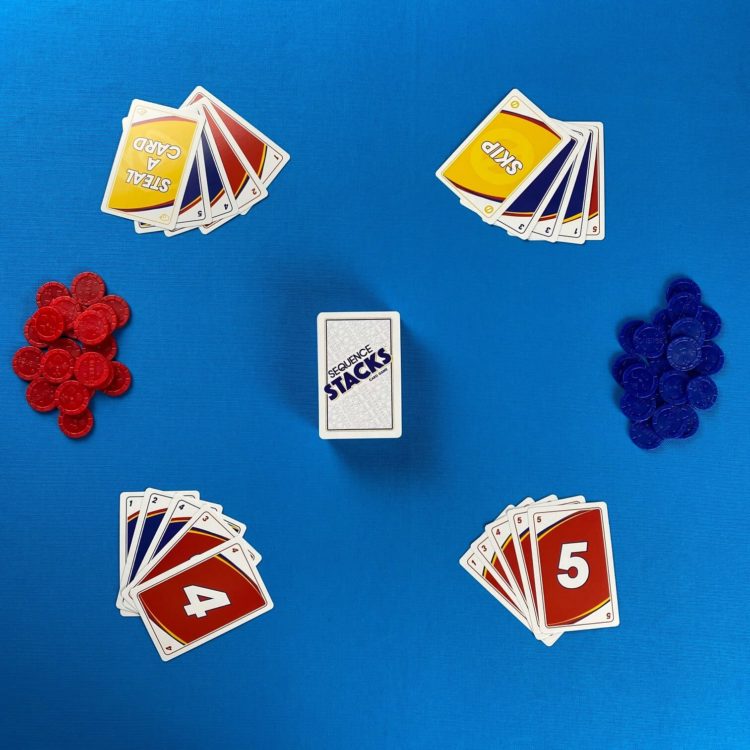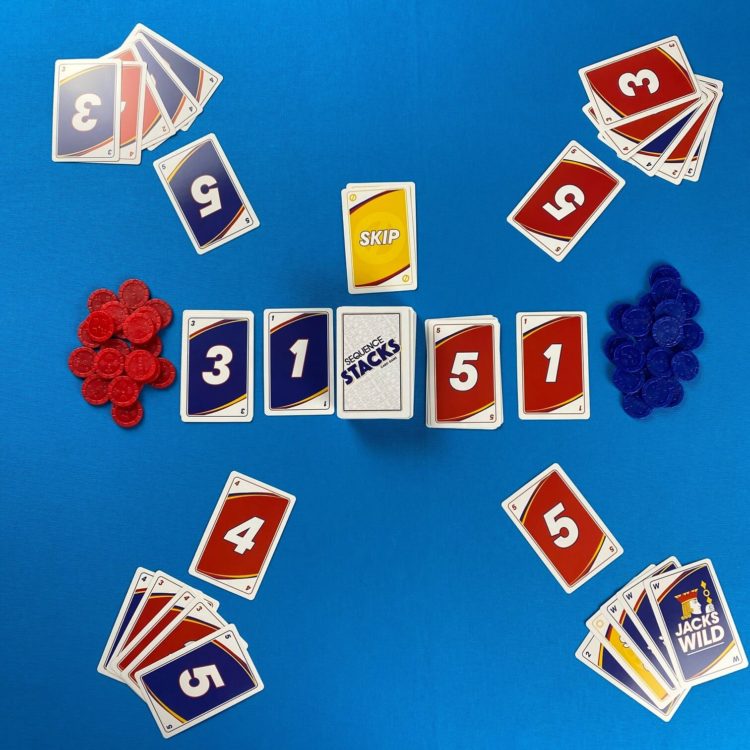
OBJECTIVE OF SEQUENCE STACKS: Be the first player to complete five sequences
NUMBER OF PLAYERS: 2 – 6 players
CONTENTS: 120 cards, 40 chips
TYPE OF GAME: Set Collection Card Game
AUDIENCE: Ages 7+
INTRODUCTION OF SEQUENCE STACKS
Sequence Stacks reimagines the classic board game Sequence as a pure card game. Rather than play chips to a board, players add cards to stacks with the goal of completing sequences of numbers 1 – 5 in the same color. When a player completes a sequence, they collect a chip, and the first player to earn five chips is the winner.
Things get a little tricky in Sequence Stacks though. Players must get both red and blue chips, and there are plenty of action cards that will give players the tools they need to mess with their opponents.
CONTENTS

The game includes a 120 card deck. There are 60 blue cards and 60 red cards. Each color has nien copies of numbers 1 – 5 and seven wild cards. Within the deck, there are sixteen action cards including three skips, three reverses, three steal-a-cards, three blocks, and four steal-a-chip cards.

SETUP
For a game that includes 3 – 6 players, all of the cards are used. For a two player game, some of the cards are removed. Remove all of the reverse cards, one block card, two steal-a-chip cards, one steal-a-card card, and one skip card.
Determine a dealer. That player shuffles the deck and deals five cards to each player. The rest of the deck is placed face down in the center of the table as a draw pile. There needs to be room for two sequence piles on either side of the draw pile. Place the blue and red chips on either side of where the sequence piles will be.

THE PLAY
The player seated left of the dealer goes first. A player may play as many cards as possible on their turn. A sequence pile must be started with a 1 or a wild card of the same color and continue in sequential order (and in the same color) until a 5 is played.
When a player is able to place a 5 on the pile (or a wild in the place of a 5), they have finished a sequence. Set the pile of cards aside and take a chip from the pile that is the same color as the sequence that was completed.
A player may continue to play cards from their hand until they are out of plays. If a player is able to play all five of the cards from their hand, they draw five more from the draw pile and continue playing.
When a player can no longer make a play, they choose one card from their hand and discard it to their own personal discard pile. The top card of the discard pile can be used during their turn.
If the draw pile ever runs out of cards, thoroughly shuffle the sequence piles that have been removed and use the new deck as a draw pile.
A player’s turn is over once they discard. Play passes left unless a reverse card has changed the turn order direction.

SPECIAL CARDS
There is a separate discard pile for special cards. When one is played, it goes into that special card discard pile. Aside from the block card, special cards can only be played by someone during their turn.
Skip cards keep the next player from taking their turn. They are skipped over and cannot play any cards.
Reverse cards change the direction of play. If the play is passing left before a reverse card is played, it now passes right instead.
Wild cards can be played as any number needed by the player. They must also be played in a sequence of the same color (blue with blue and red with red).
Steal a Card allows the player to take the top card of an opponent’s discard pile and add it to their hand.
Steal a Chip allows the player to take any one chip from an opponent’s pile. However, this card cannot be used to win the game.
Block cards can be played at any time. When a player lays a five or wild down to finish a sequence, an opponent can immediately block it. The sequence is discarded and no chip is collected.
WINNING
Play continues until one player has collected five chips. At least two of them must be red, and at least two of them must be blue. The first player to accomplish this wins the game.
- TRIPLE SNAKES - February 15, 2021